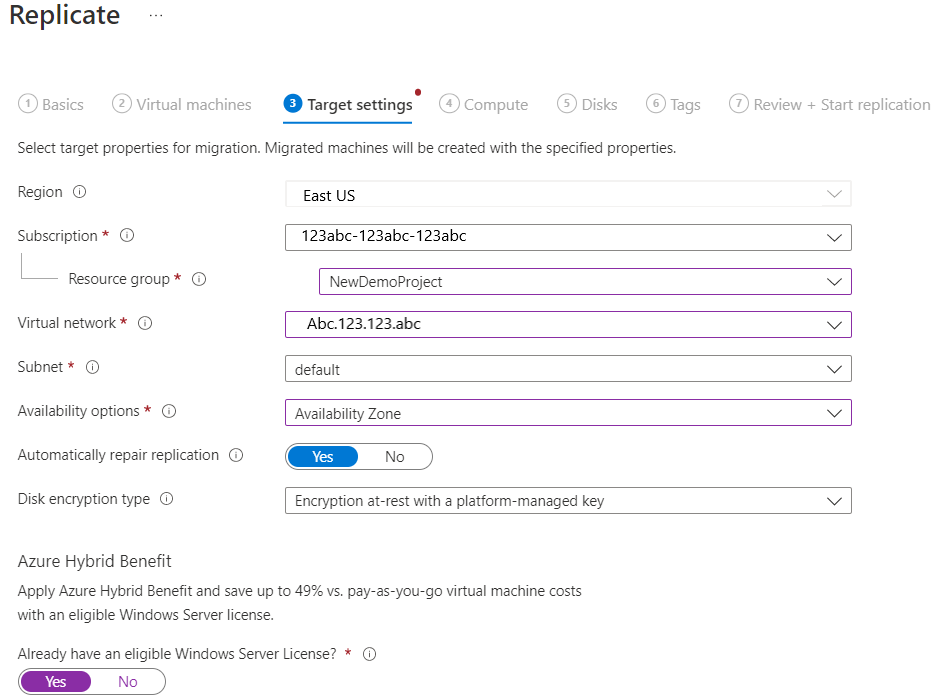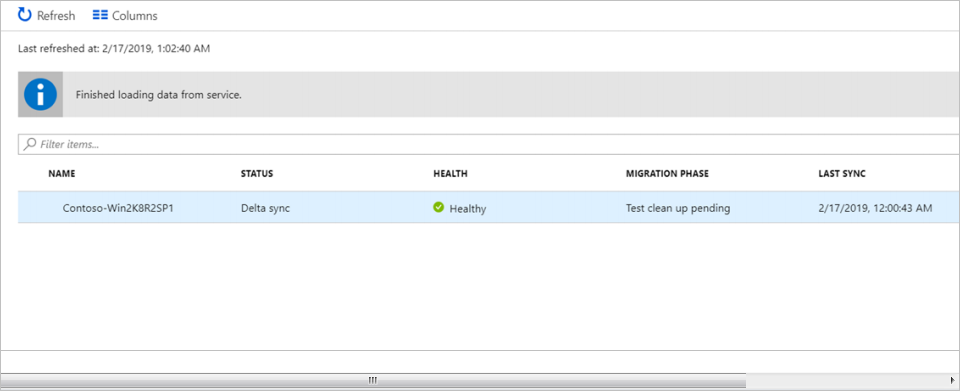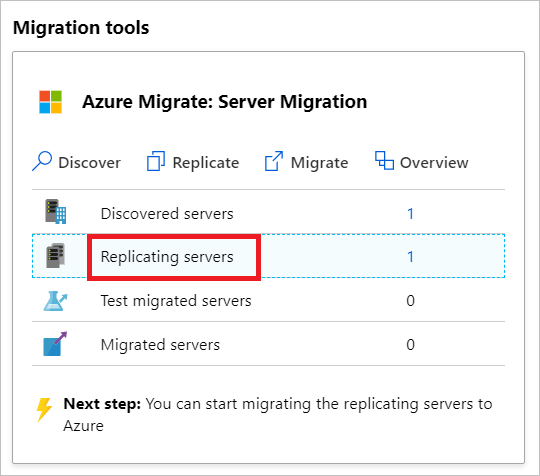Migrate Hyper-V VMs to Azure
This article shows you how to migrate on-premises Hyper-V virtual machines (VMs) to Azure with the Migration and modernization tool.
This tutorial is the third in a series that demonstrates how to assess and migrate machines to Azure.
Note
Tutorials show you the simplest deployment path for a scenario so that you can quickly set up a proof of concept. Tutorials use default options where possible and don't show all possible settings and paths.
In this tutorial, you learn how to:
- Add the Migration and modernization tool.
- Discover VMs you want to migrate.
- Start replicating VMs.
- Run a test migration to make sure everything's working as expected.
- Run a full VM migration.
If you don't have an Azure subscription, create a free account before you begin.
Prerequisites
Before you begin this tutorial, you should:
- Review the Hyper-V migration architecture.
- Review Hyper-V host requirements for migration and the Azure URLs to which Hyper-V hosts and clusters need access for VM migration.
- Review the requirements for Hyper-V VMs that you want to migrate to Azure.
- We recommend that you assess Hyper-V VMs before you migrate them to Azure, but you don't have to.
- Go to the already created project or create a new project.
- Verify permissions for your Azure account. Your Azure account needs permissions to create a VM, write to an Azure managed disk, and manage failover operations for the Recovery Services vault associated with your Azure Migrate project.
Note
If you're planning to upgrade your Windows operating system (OS), Azure Migrate and Modernize might download the Windows SetupDiag for error details in case upgrade fails. Ensure that the VM created in Azure after the migration has access to SetupDiag. If there's no access to SetupDiag, you might not be able to get detailed OS upgrade failure error codes, but the upgrade can still proceed.
Download the provider
For migrating Hyper-V VMs, the Migration and modernization tool installs software providers (Azure Site Recovery provider and Recovery Services agent) on Hyper-V hosts or cluster nodes. The Azure Migrate appliance isn't used for Hyper-V migration.
In the Azure Migrate project, select Servers, databases, and web apps > Migration and modernization > Discover.
In Discover machines > Are your machines virtualized?, select Yes, with Hyper-V.
In Target region, select the Azure region to which you want to migrate the machines.
Select Confirm that the target region for migration is region-name.
Select Create resources. This step creates a Recovery Services vault in the background.
- If you already set up migration with the Migration and modernization tool, this option won't appear because resources were set up previously.
- You can't change the target region for this project after you select this button.
- All subsequent migrations are to this region.
In Prepare Hyper-V host servers, download the Hyper-V Replication provider and the registration key file.
- The registration key is needed to register the Hyper-V host with the Migration and modernization tool.
- The key is valid for five days after you generate it.

Copy the provider setup file and registration key file to each Hyper-V host (or cluster node) running the VMs you want to replicate.
Install and register the provider
To install and register the provider, use the following steps by using either the UI or commands.
Run the provider setup file on each host:
- Select the file icon in the taskbar to open the folder where the installer file and registration key are downloaded.
- Select the AzureSiteRecoveryProvider.exe file.
- In the provider installation wizard, ensure that On (recommended) is selected and then select Next.
- Select Install to accept the default installation folder.
- Select Register to register this server in the Recovery Services vault.
- Select Browse.
- Locate the registration key and select Open.
- Select Next.
- Ensure that Connect directly to Azure Site Recovery without a proxy server is selected and then select Next.
- Select Finish.
After you install the provider on hosts, go to the Azure portal and in Discover machines, select Finalize registration.

It can take up to 15 minutes after finalizing registration until discovered VMs appear in the Migration and modernization tile. As VMs are discovered, the Discovered servers count rises.
Replicate Hyper-V VMs
After discovery is finished, you can begin the replication of Hyper-V VMs to Azure.
Note
You can replicate up to 10 machines together. If you need to replicate more, replicate them simultaneously in batches of 10.
In the Azure Migrate project, select Servers, databases, and web apps > Migration and modernization > Replicate.
In Replicate > Source settings > Are your machines virtualized?, select Yes, with Hyper-V. Then select Next: Virtual machines.
In Virtual machines, select the machines you want to replicate.
If you ran an assessment for the VMs, you can apply VM sizing and disk type (premium/standard) recommendations from the assessment results. To do this step, in Import migration settings from an Azure Migrate assessment?, select Yes.
If you didn't run an assessment, or you don't want to use the assessment settings, select No.
If you selected to use the assessment, select the VM group and assessment name.

In Virtual machines, search for VMs as needed and check each VM you want to migrate. Then, select Next: Target settings.
In Target settings, select the target region to which you'll migrate, the subscription, and the resource group in which the Azure VMs will reside after migration.
In Replication Storage Account, select the Azure Storage account in which replicated data will be stored in Azure.
In Virtual Network, select the Azure virtual network/subnet to which the Azure VMs will be joined after migration.
In Availability options, select:
- Availability Zone: Pins the migrated machine to a specific availability zone in the region. Use this option to distribute servers that form a multinode application tier across availability zones. If you select this option, you need to specify the availability zone to use for each of the selected machines on the Compute tab. This option is only available if the target region selected for the migration supports availability zones.
- Availability Set: Places the migrated machine in an availability set. The target resource group that was selected must have one or more availability sets to use this option.
- No infrastructure redundancy required: Use this option if you don't need either of these availability configurations for the migrated machines.
In Azure Hybrid Benefit:
- Select No if you don't want to apply Azure Hybrid Benefit. Then select Next.
- Select Yes if you have Windows Server machines that are covered with active Software Assurance or Windows Server subscriptions and you want to apply the benefit to the machines you're migrating. Then select Next.

In Compute, review the VM name, size, OS disk type, and availability configuration (if selected in the previous step). VMs must conform with Azure requirements.
- VM size: If you're using assessment recommendations, the VM size dropdown list contains the recommended size. Otherwise, Azure Migrate and Modernize picks a size based on the closest match in the Azure subscription. Alternatively, pick a manual size in Azure VM size.
- OS disk: Specify the OS (boot) disk for the VM. The OS disk is the disk that has the operating system bootloader and installer.
- Availability Set: If the VM should be in an Azure availability set after migration, specify the set. The set must be in the target resource group you specify for the migration.
In Disks, specify the VM disks that need to be replicated to Azure. Then select Next.
- You can exclude disks from replication.
- If you exclude disks, they won't be present on the Azure VM after migration.
In Tags, choose to add tags to your VMs, disks, and NICs.
In Review and start replication, review the settings and select Replicate to start the initial replication for the servers.
Note
You can update replication settings any time before replication starts in Manage > Replicating machines. Settings can't be changed after replication starts.
Provision for the first time
If this is the first VM you're replicating in the Azure Migrate project, the Migration and modernization tool automatically provisions these resources in the same resource group as the project.
- Cache storage account: The Site Recovery provider software installed on Hyper-V hosts uploads replication data for the VMs configured for replication to a storage account (known as the cache storage account or log storage account) in your subscription. Azure Migrate and Modernize then copies the uploaded replication data from the storage account to the replica-managed disks corresponding to the VM. The cache storage account needs to be specified while configuring replication for a VM. The Azure Migrate portal automatically creates one for the Azure Migrate project when replication is configured for the first time in the project.
Track and monitor
- When you select Replicate, a Start Replication job begins.
- When the Start Replication job finishes successfully, the machines begin their initial replication to Azure.
- After initial replication finishes, delta replication begins. Incremental changes to on-premises disks are periodically replicated to Azure.
You can track job status in the portal notifications.
You can monitor replication status by selecting Replicating servers in Migration and modernization.

Run a test migration
When delta replication begins, you can run a test migration for the VMs before you run a full migration to Azure. We highly recommend that you do this step at least once for each machine before you migrate it.
- Running a test migration checks that migration works as expected, without affecting the on-premises machines, which remain operational and continue replicating.
- Test migration simulates the migration by creating an Azure VM by using replicated data. (The test usually migrates to a nonproduction Azure virtual network in your Azure subscription.)
- You can use the replicated test Azure VM to validate the migration, perform app testing, and address any issues before full migration.
To do a test migration:
In Migration goals, select Servers, databases, and web apps > Migration and modernization > Test migrated servers.

Right-click the VM to test and select Test migrate.

In Test Migration, select the Azure virtual network in which the Azure VM will be located after the migration. We recommend that you use a nonproduction virtual network.
You can upgrade the Windows Server OS during test migration. For Hyper-V VMs, automatic detection of an OS isn't yet supported. To upgrade, select the Check for upgrade option. In the pane that appears, select the current OS version and the target version to which you want to upgrade. If the target version is available, it's processed accordingly. Learn more.
The Test Migration job starts. Monitor the job in the portal notifications.
After the migration finishes, view the migrated Azure VM in Virtual Machines in the Azure portal. The machine name has the suffix -Test.
After the test is finished, right-click the Azure VM in Replications and select Clean up test migration.

Note
You can now register your servers running SQL Server with SQL VM RP to take advantage of automated patching, automated backup, and simplified license management by using the SQL IaaS Agent Extension.
- Select Manage > Replications > Machine containing SQL server > Compute and Network and select yes to register with SQL VM RP.
- Select Azure Hybrid Benefit for SQL Server if you have SQL Server instances that are covered with active Software Assurance or SQL Server subscriptions and you want to apply the benefit to the machines you're migrating.
Migrate VMs
After you verify that the test migration works as expected, you can migrate the on-premises machines.
In the Azure Migrate project, select Servers, databases, and web apps > Migration and modernization > Replicating servers.

In Replicating machines, right-click the VM and select Migrate.
In Migrate > Shut down virtual machines and perform a planned migration with no data loss, select Yes > OK.
- By default, Azure Migrate and Modernize shuts down the on-premises VM and runs an on-demand replication to synchronize any VM changes that occurred since the last replication occurred. This action ensures no data loss.
- If you don't want to shut down the VM, select No.
You can upgrade the Windows Server OS during migration. For Hyper-V VMs, automatic detection of OS isn't yet supported. To upgrade, select the Check for upgrade option. In the pane that appears, select the current OS version and the target version to which you want to upgrade. If the target version is available, it's processed accordingly. Learn more.
A migration job starts for the VM. Track the job in Azure notifications.
After the job finishes, you can view and manage the VM from the Virtual Machines page.
Complete the migration
- After the migration is finished, right-click the VM and select Stop replication. This action:
- Stops replication for the on-premises machine.
- Removes the machine from the Replicating servers count in the Migration and modernization tool.
- Cleans up replication state information for the VM.
- Verify and troubleshoot any Windows activation issues on the Azure VM.
- Perform any post-migration app tweaks, such as updating host names, database connection strings, and web server configurations.
- Perform final application and migration acceptance testing on the migrated application now running in Azure.
- Cut over traffic to the migrated Azure VM instance.
- Remove the on-premises VMs from your local VM inventory.
- Remove the on-premises VMs from local backups.
- Update any internal documentation to show the new location and IP address of the Azure VMs.
Post-migration best practices
- For increased resilience:
- Keep data secure by backing up Azure VMs by using Azure Backup. Learn more.
- Keep workloads running and continuously available by replicating Azure VMs to a secondary region with Site Recovery. Learn more.
- For increased security:
- Lock down and limit inbound traffic access with Microsoft Defender for Cloud - Just-in-time administration.
- Manage and govern updates on Windows and Linux machines with Azure Update Manager.
- Restrict network traffic to management endpoints with network security groups.
- Deploy Azure Disk Encryption to help secure disks and keep data safe from theft and unauthorized access.
- Read more about securing IaaS resources and Microsoft Defender for Cloud.
- For monitoring and management:
- Consider deploying Microsoft Cost Management to monitor resource usage and spending.
Next steps
Investigate the cloud migration journey in the Cloud Adoption Framework for Azure.
Feedback
Coming soon: Throughout 2024 we will be phasing out GitHub Issues as the feedback mechanism for content and replacing it with a new feedback system. For more information see: https://aka.ms/ContentUserFeedback.
Submit and view feedback for


